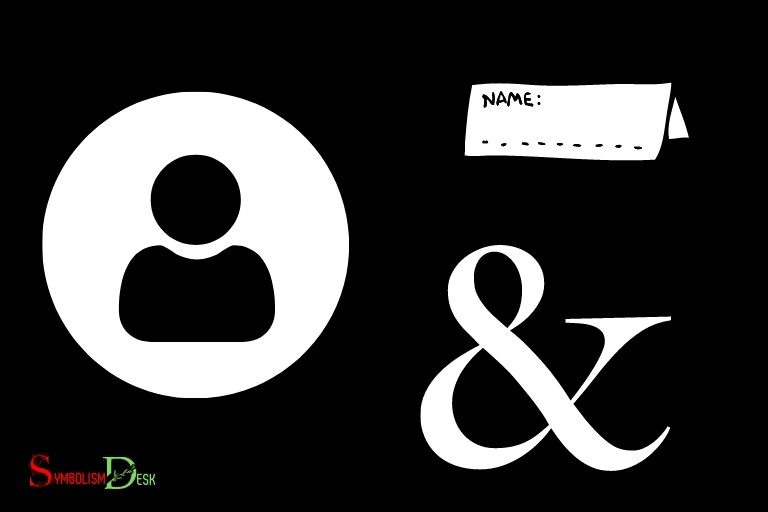Name of Signs And Symbols: Find Out Here!
Signs and symbols are visual representations used to convey information, ideas, or concepts and can be found in various forms across different cultures and industries.
Signs and symbols are essential components of human communication, aiding in conveying messages, beliefs, and even emotions.
They help people understand the world around them and make sense of their surroundings. These symbols can be simple illustrations, complex patterns, or even abstract representations.
The use of signs and symbols is an integral aspect of human communication and understanding. They come in many forms and serve various purposes, ranging from guiding us on the road to representing deeply held beliefs.
By understanding and interpreting these symbols, we can better navigate our world and connect with others.
42 Symbols & Their Names
| Symbol | Name |
|---|---|
| & | Ampersand |
| @ | At symbol |
| # | Hash / Pound sign |
| % | Percent sign |
| ^ | Caret |
| * | Asterisk |
| ( | Open parenthesis |
| ) | Close parenthesis |
| – | Hyphen / Minus sign |
| + | Plus sign |
| = | Equal sign |
| [ | Open square bracket |
| ] | Close square bracket |
| { | Open curly brace |
| } | Close curly brace |
| ; | Semicolon |
| : | Colon |
| , | Comma |
| . | Period / Full stop |
| ? | Question mark |
| ! | Exclamation mark |
| < | Less than sign |
| > | Greater than sign |
| / | Forward slash |
| \ | Backslash |
| “ | Quotation mark |
| ‘ | Apostrophe |
| ` | Backtick / Grave accent |
| ~ | Tilde |
| € | Euro sign |
| £ | Pound sterling sign |
| ¥ | Yen sign |
| ¢ | Cent sign |
| © | Copyright symbol |
| ® | Registered trademark |
| ™ | Trademark symbol |
| ° | Degree symbol |
| ± | Plus-minus sign |
| × | Multiplication sign |
| ÷ | Division sign |
| √ | Square root symbol |
| ∞ | Infinity symbol |
Key Takeaway

Four Facts About Name Of Signs And Symbols
Understanding The History And Significance Of Sign And Symbols
Signs and symbols have been a significant part of human civilization, with their origins dating back to the period of early human history.
As a means of communication, they played an essential role in expressing human thoughts, emotions and abstract ideas.
Today, in the modern era, signs and symbols remain as relevant and important as ever before.
In this section, we will explore the history and significance of signs and symbols, including archaeological signs and symbols, religious symbols, cultural symbols and conceptual and ideological symbols.
Archaeological Signs And Symbols
Archaeological signs and symbols have been discovered throughout the world, and they provide valuable insights into the cultural and social practices of ancient societies.
Here are some key points:
Religious Symbols
Religious symbols are icons that represent the beliefs and practices of a particular religion. They play a vital role in the lives of people who practice a religion and are a direct reflection of their faith.
Here are some key points:
Cultural Symbols
Cultural symbols depict the values, beliefs and customs of a particular culture. They play a crucial role in understanding the history, traditions and identity of a society.
Here are some key points:
- The greek parthenon represents the high point of ancient greek architecture and is an example of the cultural legacy left by the ancient greeks.
- The balinese barong and rangda masks represent the battle between good and evil in balinese culture, seen as an essential ritual in their religious practices.
- The african tribal mask has significant value and is used in their traditions, ceremonies, as a form of art and as an expression of their emotions and spirits.
Conceptual And Ideological Symbols
Conceptual and ideological symbols express abstract ideas, concepts and ideologies. They play an important role in conveying messages and creating awareness about such ideas.
Here are some key points:
- The yin yang symbolizes the balance of opposing forces in chinese philosophy, such as good and evil, light and dark, and day and night.
- The peace sign is internationally recognized as a symbol of peace and has been used in anti-war protests worldwide.
- The heart symbol represents love, affection, and emotion, and has become a universal symbol of love and compassion.
Signs and symbols have been essential tools in human communication and expression. They provide a window into the past and a lens through which we can view contemporary society today.
By understanding their history and significance, we can appreciate their importance in our world, and how they continue to shape our perceptions and communication.
Introduction To Name Of Signs And Symbols
Signs and symbols are an essential part of our lives. We use them every day to communicate messages, express emotions and convey important information.
The name of signs and symbols has become an essential topic for people interested in graphic design, typography, and communication theories.
Why The Name Is Important
The name of signs and symbols is essential because it provides a common language for communication.
Names help us to identify an object, concept or brand easily. A well-chosen name can convey a message or an emotion, which aids in brand recognition.
The significance of a name in graphic design is that it helps the viewer to understand the underlying message by identifying the symbol’s meaning.
Conventions In Naming Symbols
Naming symbols involve several conventions that designers must follow.
Origins Of Naming Conventions
Naming conventions originate from early forms of written communication that used pictorial symbols to convey ideas.
The ancient egyptians, greeks, and romans created symbols that represented gods, animals, and concepts. With the invention of printing, symbols became more formalized, and naming conventions emerged.
For example, the symbols used in the periodic table have specific names that identify the element it represents. Naming conventions continued to evolve with the growth of technology and modern communication.
The name of signs and symbols is essential in communication and graphic design. Understanding conventions in naming symbols and their origins helps us to create effective symbols that convey a clear message to the viewer.
With this knowledge, we can create symbols that are memorable, universal, and easily identifiable.
The Role Of Name In Sign And Symbol Reception
Perceptions And Interpretations Of Name And What It Represents
A name is a word or set of words that represent something or someone. In symbol reception, name plays a vital role in shaping people’s perceptions and interpretations.
Here are some key points:
- People have preconceived notions and associations for names based on their past experiences and cultural background.
- The perceived meaning of a name can affect how people react to the associated symbol or sign.
- Clear and concise names can make it easier for people to remember and understand the associated symbol.
Cultural And Linguistic Influences In Naming Conventions
Naming conventions can vary greatly across different cultures and languages.
Here are some things to keep in mind:
- In some cultures, symbols and signs might use characters that have a different meaning in other languages.
- Different languages have different naming conventions. For example, english-language signs might use all-capital letters, while other languages may capitalize only the first letter of a word.
- Depending on the audience and context, it might be necessary to adapt the name of a symbol or sign to better suit the cultural or linguistic context.
Naming Symbols For Maximum Effectiveness
Choosing the name for a symbol or sign can greatly affect its impact on the intended audience.
Here are some tips for picking an effective name:
- Keep the name simple and easy to remember.
- Make the name descriptive, giving an idea of what the symbol or sign represents.
- Avoid using jargon or overly technical terms that might be unfamiliar to the audience.
- Conduct user testing to ensure the name you’ve chosen resonates with the intended audience.
Examples Of Name Of Signs And Symbols In Various Fields
Name Of Signs And Symbols
Symbols and signs are part of human communication since ancient times. They convey meaning, emotions, and ideas, and enable us to understand complex information with ease.
Different fields use various symbols and signs for communication and representation. In this blog, we will explore the types and examples of name of signs and symbols in various fields. For example, in the field of mathematics, symbols such as +, -, x, and ÷ are used to represent addition, subtraction, multiplication, and division. In music, symbols like treble clef, bass clef, and notes like whole, half, and quarter are used to represent musical pitches and durations. @ symbol origins can be traced back to the 16th century, where it was used as a shorthand for the word “at” in commercial transactions. In the field of computer science, symbols like <, >, =, and ! are used for logical comparisons and operations. Each field has its own set of symbols and signs that are essential for communication and representation.
Scientific Symbols And Nomenclature
Science is a field that deals with complex theories and concepts, which require precise communication.
Scientific symbols and nomenclature help scientists and researchers to communicate complex ideas with ease.
Here are some key points:
- The international system of units (si) uses standard symbols for measurement, such as m for meters, kg for kilograms, and s for seconds.
- Chemical formulas and equations use symbols such as h for hydrogen, o for oxygen, na for sodium, and cl for chlorine.
- The periodic table of elements uses symbols for different elements such as c for carbon, fe for iron, and au for gold.
- Genetics and biology use symbols for representing genes, dna sequences, and protein sequences, such as a for adenine, t for thymine, g for guanine, and c for cytosine.
Business And Branding Symbols
Logos and symbols are an essential part of branding and business communication. They help companies to create a unique identity and promote brand recognition.
Here are some key points:
- Logos and branding symbols represent a company’s message, values, and vision.
- Famous branding symbols like mcdonald’s golden arches, apple’s bitten apple, and nike’s swoosh are recognized globally and have become an integral part of popular culture.
- By using symbols in marketing campaigns, companies can create a unique message that resonates with their audience and attracts new customers.
Political Symbols And Iconography
Political symbols and iconography help political parties to communicate their message and ideology to the public.
They represent the values, beliefs, and ideology of political parties and often become a part of popular culture.
Here are some key points:
- National flags are the most recognized political symbol globally, representing a nation’s values, culture, and political system.
- Political parties use symbols like the donkey for democrats and the elephant for republicans in the united states and the bharatiya janta party’s lotus symbol in india.
- Political posters and symbols have been used to mobilize social movements and revolutions, such as the raised fist symbol and the black power salute.
Cultural Symbols And The Arts
Cultural symbols and the arts are an integral part of human communication and expression. They enable us to understand different cultures, beliefs, and values worldwide.
Here are some key points:
- Music and art use different symbols to represent emotions, ideas, and expressions, such as musical notes, rhythm, and colors.
- Different cultures have unique symbols that represent their values, beliefs, and ideologies.
- Cultural symbols like yin and yang in china, om in hinduism, and the star of david in judaism are recognized globally as symbols of their respective ideologies and beliefs.
Name of signs and symbols in different fields represent a form of communication that is integral to human life. They convey complex ideas with ease and help us to understand different cultures and people worldwide.
What Is the Symbolic Meaning of the Fleur-de-Lis?
The saints symbol: fleur-de-lis holds a rich symbolic meaning. Often associated with royalty and nobility, it represents purity, spirituality, and divine light. With its distinct three-petal design, the fleur-de-lis has been used in heraldry, architecture, and religious art throughout history, depicting love, grace, and the Holy Trinity. Its significance extends beyond one culture or era, making it a timeless emblem of elegance and virtue.
FAQ For Name Of Signs And Symbols
What Are The Different Types Of Signs And Symbols?
Signs and symbols can be categorized into five types: iconic, indexical, symbolic, signals, and codes.
What Is The Importance Of Signs And Symbols In Communication?
Signs and symbols are important in communication as they convey messages at a glance and are universal, making them understandable to people of different cultures.
How Do Signs And Symbols Differ From Each Other?
Signs are more concrete and tangible, conveying a specific message, while symbols are more abstract and can represent multiple meanings.
What Are Some Commonly Recognized Signs And Symbols?
Commonly recognized signs and symbols include the peace symbol, the gender icons, the recycling symbol, stop signs, warning signs, and directional signs.
How Have Signs And Symbols Evolved Over Time?
Signs and symbols have evolved over time with the advancement of technology, changes in cultural norms, and the development of new universal symbols such as emojis.
Conclusion
Symbols and signs play an essential role in our daily lives and can convey significant meaning through a single image. From traffic signs to corporate logos, they evoke emotions, influence behavior, and enable our communication with the world.
The proper interpretation of these symbols is crucial as they could provide us with essential information.
However, it is equally crucial to recognize and comprehend the hidden meanings represented by these signs and symbols.
By being aware of their significance, we can differentiate between fact or fiction, and false interpretations can be avoided. Symbolism is a universal language that transcends boundaries, culture and time.
So next time we cross a road or come across a logo, think about the meaning it represents. Awareness of symbols and their meaning can enable us to interpret our surroundings better and communicate more efficiently.
Understanding symbols and their representation, is undoubtedly beneficial in our fast pace, visual world.






